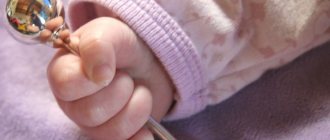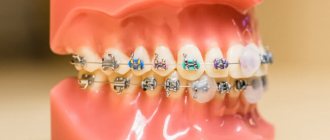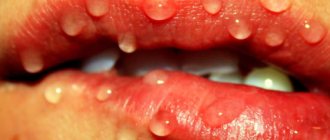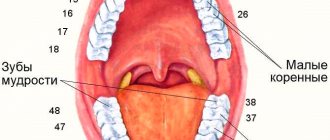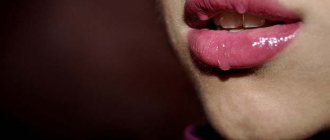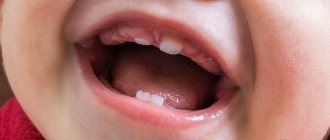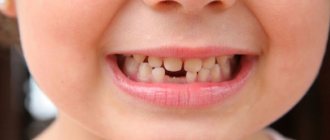The first tooth - signs and customs
Doctors have determined that the appearance of the first baby teeth should occur approximately between the fourth and seventh month of life. Signs when the first tooth comes out before 4 months promise that the young mother will soon give birth to another baby. To determine the timing of the birth of your second child, you need to pay attention to whether the top or bottom came first. If they are upper, then an increase should be expected in a maximum of a year.
If the appearance of the first incisors occurred after seven months, then this is an excellent sign. Most likely, the child will have either unique talents or superpowers. However, some nationalities have a completely opposite opinion on this matter.
A sign of good fortune and popularity among peers and members of the opposite sex will be a gap between the upper front incisors. Moreover, the longer the gap, the more this sign works.
A bad sign would be a long period of teething, which takes longer than nature predetermines. This process foreshadows that in the future the child will be very demanding and capricious. Most likely, he will suffer from bouts of hysterics and depression.
In very rare (almost isolated) cases, a child’s first tooth appears during pregnancy. They used to say about such newborns that they would not live to see a year, or they would serve black forces. The first tooth, the canine, used to have the same meaning. Modern people have stopped believing such superstitions because statistics do not confirm them.
When a child’s first tooth grows - signs, superstitions
Signs and customs will tell you a lot about the first tooth: about the further development of the baby, how to attract good luck and wealth to him. Don't collect information bit by bit - you will find the most valuable and informative here.
Relatives of a newborn toddler like to rush things: everyone tries to be the first to notice changes in his life. The little man's successes are heartwarming.
And when the first tooth appears in the baby’s mouth, the parent’s joy knows no bounds!
How to properly celebrate a special event, taking into account the signs known about the first tooth?
During the dangerous, but important period for the baby, coral amulets were hung in the house. A necklace made by a clan elder or a shaman with woven red silk ribbons (9 pieces) tied with knots at equal distances was attached to the cradle.
The sign says: whoever notices the erupted tooth first will receive an expensive gift for the child.
Many argue that it should be a silver spoon (a sign that the baby will soon begin to eat on his own). This metal has cleansing and antibacterial properties.
According to ancient popular belief, a silver spoon is given to the godson for the sacrament of baptism by the appointed godparents (godfathers).
There is one more sign about silver cutlery: tap a tooth with a spoon so that the rest grow well. It most likely happened as a result of checking whether the tooth had come out or not (they tapped the gums with a spoon and listened to see if it would clink.
A serious celebration begins when all the relatives gather in the house for this occasion. While mom is taking food supplies out of the bins, objects from different professions are laid out on the table: a hammer, scissors, a stethoscope, a steering wheel, a jigsaw, a microphone, notebooks, books, and much more.
The baby is seated in the middle of this stuff, the things are covered with a sheet, and then, sprinkled with grains of wheat and barley, as well as sweets, they say:
“Grow strong, healthy, intact and white teeth. And you, baby, grow up healthy, smart, strong and happy!”
They take off the sheet and wait to see what item the child will pick up first:
- if he grabs a hammer, he will become a carpenter;
- If you like the steering wheel, the driver is growing;
- reaches for scissors - hairdressing talent will develop and the like.
The fun fortune-telling ends with a massive feast with beautiful songs and toasts to the health of the baby.
Some superstitions about teeth are so frightening and absurd that it is better for young mothers not to know about them.
For example, if a child is born with teeth, he will be capricious, domineering and bloodthirsty.
A controversial sign: if a child’s first tooth appears on the upper gum, it means an early death awaits him. However, there are more superstitions that predict an early pregnancy for the mother.
The Slavs determined how many children there would be in the family by the number of teeth in the first-born child, who was one year old. But according to medical indicators, the norm is eight teeth. Imagine how many large families there should be in the world.
Russians and Englishmen have different interpretations of the sign about the gap between the front teeth: the Scots believe that such people will go through life happily, but the Slavs endow them with a deceitful nature.
If the baby’s first teeth are wide and even, he will grow up to be good-natured, but small and narrow, he will be a petty, greedy and cunning person.
The conclusion suggests itself: you should not believe in bad omens, but good ones will justify themselves. The main thing is that the child grows up in a happy and healthy atmosphere, and the dairy ones will definitely be replaced by indigenous ones.
There are so many popular beliefs associated with infancy that you should not wait until the first tooth comes out. Signs can tell what a child will be like based on the characteristic behavioral and external signs of his future parents. By how it develops in the womb, on what day it was born.
Since there are signs and customs associated with the appearance of the first tooth, people also took care of the beliefs associated with the beginning of their loss.
“Mouse-mouse, come, take Alenka’s (Vanechka’s) tooth and bring him a gift!”
At night, when your child is sound asleep, carefully replace the box with a gift.
Among modern traditions, the legend of the existence of the tooth fairy has taken root. The meaning of the ritual is the same: the one that falls out is placed under the pillow, and the sorceress takes it away, replacing it with a gift.
The character was invented at the end of the 19th century for the little Spanish king by writer Luis Coloma. For more than a hundred years she has been coming to children.
The main thing to remember is that you can’t give it away on Christmas, otherwise something bad will happen to her.
How best to celebrate the loss of the first baby tooth - by calling a mouse, a fairy or a brownie - is up to the parents to decide. It is important for your child that all his events are meaningful to you. He should always be sure that he will find love and support in his family.
Source: https://charybary.ru/poveria/pervyie-zubki-primetyi/
How to celebrate the first tooth and what is customary to give as a gift
Signs when the first tooth comes out, almost everyone agrees that a spoon made of silver should be presented as a gift for such an event. Such a gift must be given at the moment when the first incisor is cut. In the old days, godparents had to buy such a gift and tap it on the protruding edge of the tooth. Such a gesture meant that soon the baby would try a new food, for which he would need to use this cutlery. Today, parents can also buy a spoon.
Having performed such a ritual, the baby is predicted to have strong and problem-free teeth throughout his life. Also, such a gift promises the little person a happy future and consistency in it.
To avoid pain during teething, the silver cutlery must be cooled and applied to the inflamed gums. This action will greatly reduce pain and help the baby calm down.
Our ancestors tried to pay as much attention as possible to their child during this period of his life. It was believed that black spirits could take advantage of a weakened state.
A child’s first baby tooth fell out: what to do with it according to signs, can it be stored?
In the modern world, people are sometimes ashamed to be superstitious.
In their opinion, signs and beliefs that came from the past are stupid and baseless. However, not everything is so simple. Superstitions appeared not as entertainment, but as a way to simplify a person’s life. Therefore, they can be used today in order to get rid of everyday or life problems.
Signs and customs regarding the first tooth are no exception to this rule. Many of the long-standing traditions have practical benefits.
The modern world and ancient customs
Today, cutting the figure eight brings its owner more pain and torment than glory and honor. It is not always possible to get rid of the culprit of sleepless nights and high fever the first time, even with the help of professional dentists.
Although sooner or later you will still have to get rid of the tooth, do not rush to do this if it does not bother you. After all, the appearance of indigenous people in the eighth row promises its owner pleasant gifts from fate.
Gypsies to this day claim that if you bury a wisdom tooth in a cemetery on a full moon, then within six months the person will become rich and lucky.
Signs when the first tooth appears
There are several different signs among people that refer to the appearance of a child’s first incisors. The usual period in which they begin to grow in babies is the age of 5–6 months.
If the tooth erupted earlier or later, this was a reason to judge the possible future of the child. We paid attention not only to the time of appearance, but also to the sequence of filling the dentition and the structural features of the jaw:
- If the first tooth comes out beyond y - the birth of a brother or sister a year after the baby was born.
- If teeth appeared with a delay relative to the traditional period (later than 7 months), the child was predicted to have talent and great achievements in a certain area.
- If a coin, turned edgewise, was placed between the baby’s two central upper teeth , the parents believed that their child would be successful with the opposite sex. The second interpretation is luck in adult life.
- The baby was born “toothy” or he first developed fangs - a bad sign, foreshadowing imminent death or service to evil in adulthood. But there is also the opposite interpretation - in adulthood a person will be very successful and lucky.
These superstitions can hardly be called relevant, because dentists have long proven that the speed of tooth formation and the structure of the jaw is determined by the innate characteristics of each child, and not by mystical reasons.
There is a belief that will help young mothers determine the moment when they can start complementary feeding.
The sign says that when the first tooth comes out, the baby should be given a spoon made of silver, and be sure to knock on the tooth with it. This action symbolized that the baby could already eat something other than his mother’s milk.
Relic of the past
The human dentition consists of eight incisors, two pairs of canines and four pairs of chewing teeth - molars. In dentistry, third molars are called “third molars,” or, more simply, “eights.” They appear when children's baby teeth have completely fallen out and molars have grown in their place. These are not belated milk teeth - the teeth are permanent and have five roots.
Many scientists recognized ZM as an atavism, a relic of the distant past, when human ancestors had to chew hard food. The jaws of primitive people were more powerful and larger, so that the dentition on them was more spacious.
It happens that the “eights” do not appear at all. Science considers this a variant of the norm.
The first baby tooth fell out: signs
There are several signs associated with the loss of a child’s first tooth. One of the customs, widespread in European countries, came from the Middle Ages. The first tooth that fell out, like all subsequent ones, had to be burned or destroyed in any other way.
It was believed that after death the soul is not able to find peace until it finds all its fallen teeth in the world. The tradition of destroying baby teeth will save the human soul in the future from the painful need to find them.
In addition, superstitious people quite often burn fallen milk teeth so that they do not fall into the hands of sorcerers and become an object for damage or the evil eye.
What does the absence of “eights” mean?
Folk superstitions about wisdom teeth challenge the opinion of science. They argue: if the “eights” did not appear, this should be interpreted as a sign of a break in a person’s connection with his ancestors. Such a person, according to popular belief, is cut off from the past.
Esotericists believe that a person with an “understaffed” dentition is energetically weak, and is more susceptible to the influence of other people’s negativity, and is vulnerable to the evil eye and damage.
It should be clarified that what has been said applies to those whose “eights” did not appear at all. If the ZM appeared, but was pulled out for medical reasons, this does not affect the energy of the individual.
However, in some cultures it is still generally accepted that only individuals with a complete set of teeth are provided with the protection of their ancestors. And in the event of the loss of at least one molar, no matter which one, the otherworldly protection weakens. Therefore, they are in no hurry to part with fallen or pulled out teeth - former owners carry them with them as talismans.
Drop customs
There are relatively modern beliefs and customs that people practice to this day. These traditions are reflected in both folklore and popular culture. Everyone knows the tradition of putting a tooth under the pillow so that the Tooth Fairy will take it, or the belief that a tooth should be thrown away in a secluded place so that the Mouse will take it and give it a healthy molar in the future.
The main purpose of these superstitions is not to instill in a child the idea of the existence of magic or higher powers. The point is to reduce the pain and discomfort of the baby at a time when his teeth are falling out and new ones are being cut.
A child, captivated by the thought of the unusualness and mystery of what is happening, will forget about the pain. In addition, some children are afraid of parting with a part of their body. For a child, giving a tooth to a kind magical creature is much calmer than throwing it in the trash or burning it.
The mouse waved its tail
The belief about the Mouse, which collects children's teeth, is widespread in Slavic countries, including Russia. For many hundreds of years, parents in Rus' have been telling this fairy tale to their children.
According to superstition, the Mouse took away the lost baby teeth from the child, in return allowing the molars to grow. The main thing in this matter was that the fallen tooth must be thrown over your shoulder behind your back so as not to see where it will fall.
Today people also practice this activity - modern children throw their teeth from balconies or in parks so that they certainly will not find them.
Fairy belief
The Tooth Fairy is widely known in Western countries. She performs approximately the same role as the Mouse - she replaces the baby's milk tooth with a molar, and the child receives some kind of reward. Most often it's just a coin or sweets.
The tradition is so well known that full-length films have even been made about it, which have had considerable box office success.
Customs when a child loses a tooth
Traditions differ among different nations, but everywhere superstitions recommend not to treat the first and subsequent lost teeth too irresponsibly. Simply throwing them away like regular garbage is prohibited everywhere.
To a modern person, many customs may seem wild and stupid; now it is becoming popular to donate such valuable biomaterial to a stem cell bank. This innovation is not yet widespread, but if the outcome of the experiment is favorable, it threatens to become a new useful tradition.
What is most often done with the first and subsequent lost milk teeth:
- turned into an amulet;
- give it to the mouse;
- put under the fairy's pillow;
- thrown into a field or forest;
- buried in a sparsely populated place or a flower pot for a houseplant.
Use as an amulet
Not all parents know what to do with their children’s baby teeth that fall out.
Superstitious people advise using the collected units to make a real amulet that protects the child from all kinds of evil. The main role here is played by the very first lost tooth, but the rest can also be used.
It is believed that the amulet will protect the owner from damage, the evil eye, conspiracies, evil spirits and all kinds of misfortunes.
Opponents of this tradition claim that you should not use biomaterial to create any objects, since this way the tooth could fall into the hands of dark magicians. In this case, the consequences can be the most dire, since milk units are used during various ceremonies and rituals.
Is it possible to store baby teeth?
There is nothing wrong with storing your child's lost teeth. There is a custom according to which relatives are obliged to keep all the lost teeth of a person until death in order to bury them with him. People believed that the soul would not find peace in the afterlife until it found all its teeth left in this world. It is easier to destroy lost teeth, but you can also store them.
Many sentimental mothers love a beautiful box where they put the tag from the maternity hospital, the first cut strand and the baby’s baby teeth. There is no mystical background to such a collection; this is just one way to capture your child’s infancy and childhood.
Can I just throw it away?
From the point of view of superstitious people, throwing away a baby's baby teeth is a bad idea. If you do this, they can end up with sorcerers and warlocks. For dark magicians, children's milk teeth are a very valuable material that can be used in rituals to cause damage, curses and the evil eye.
There is a belief that if a discarded baby tooth is found and swallowed by some animal, the child will acquire the features of this animal in his appearance and behavior. He may have enlarged fangs, instead of a smile there will be a predatory grin, he will become aggressive and uncontrollable.
Therefore, it is forbidden to simply throw away baby teeth, because this can lead to negative consequences.
What should you do with a lost tooth if you don’t want to keep it in your apartment? If the Fairy “took” it, you can bury the tooth in a secluded place. If a child wants to “give” it to the Mouse, he throws it out in the park or in the field.
Most modern mothers do not believe in omens about baby teeth. But you shouldn’t refuse the “help” of the Tooth Fairy or Mouse, who will take the tooth for themselves. These cute traditions will bring a little magic into your baby’s life, calm you down and teach you how to better care for your teeth.
What does the chipper say?
All the signs of happiness are there!
In Russia, those with a front gap were considered from birth endowed with a cheerful disposition and the ability to effortlessly conquer the opposite sex. And someone says that it’s a flaw... They don’t understand anything!
A large gap between the teeth, into which a silver coin could fit, was considered in England a sign of wealth and good luck awaiting a person. And in general, in the European tradition, rare teeth definitely promised the lucky one a life full of travel and interesting adventures. True, not too long.
Read also: Removal of an impacted tooth - what is it?
Small and closely seated teeth in the gums are considered a sign of a tight-fisted, mischievous, but amorous person.
What to do with the first tooth that falls out - keep it or throw it away: let’s get acquainted with the signs
Many parents believe that a child becomes an adult when his first baby tooth falls out.
Therefore, it is not surprising that they are interested in at what age and how this happens? What can parents do to help their child? Read about all this in our article.
Controversial statements of contemporaries
Today, the presence of a wisdom tooth is not considered something mystical and does not at all mean that its owner has a great mind. One contemporary expressed his attitude to this issue with the following statement:
For some individuals, the presence of a wisdom tooth is the only evidence of intelligence.
Source: https://dentaclass.ru/deti/kuda-devat-vypavshie-molochnye-zuby.html
